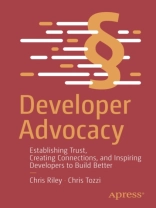No matter which point you’re currently at on the developer advocacy journey – whether you’ve already implemented a developer advocate function or you’re exploring the possibility – this book is for you. This book provides actionable guidance that business and technology leaders can use to understand the benefits of advocacy, identify what goes into the function, and learn how to maximize the success of developer advocate teams.
Developer advocacy is a role that is sometimes hard to quantify and build – but you feel it when you’re missing it. Companies are struggling to solidify advocacy despite a strong desire to do so and little guidance exists for businesses seeking to build a developer advocacy program or assess its effectiveness. This book will show you how to get an advocacy program in your business: the basics of having an advocacy program, what tasks and processes need to be set up, and how to identify key stakeholders.
You’ll see how companies of all types that sell to or engage with technical audiences can develop a developer advocacy strategy. Specifically, you’ll learn what developer advocates do, how business can start an advocacy practice in your organization and how to scale and operationalize such a practice once it is in place. The book will further explore the metrics for measuring advocacy success and ways the scale advocacy teams internally and externally.
The Power of Developer Advocacy explores the exciting career path of advocacy for developers and engineers.
What You Will Learn
- Discover what developer advocacy is
- Determine which sorts of companies need the function
- Understand what the primary strategic considerations for developer advocacy is
Who This Book is For
Existing and future advocacy leaders, would-be developer advocates, developer marketers and Dev Rel teams and leaders
Jadual kandungan
Chapter 1: What is Advocacy?.- Chapter 2: Becoming a Developer Advocate.- Chapter 3: Starting a Developer Advocacy Team.- Chapter 4: Managing Work Output for your New Advocacy Team.- Chapter 5: Getting Started with Content for Developer Advocacy.- Chapter 6: Understanding and Optimizing Stakeholders in Developer Advocacy.- Chapter 7: Growing: Creating an Advocacy Roadmap.- Chapter 8: Amplifying Advocacy’s Impact.- Chapter 9: Measuring Advocacy’s Impact.- Chapter 10: Parting Thoughts on Successful Developer Advocacy.
Mengenai Pengarang
Chris Tozzi
Chris’s career has combined two seemingly disparate passions: Tech and history. A long-time Linux geek who earned a Ph.D. in French revolutionary history from Johns Hopkins, Chris lived the dream as a tenured professor for several years until boredom with academia prompted him to expand his horizons. Today, Chris keeps his inner historian happy by teaching part-time at a major research university, where his courses cover technology, culture and society. Meanwhile, he keeps his geek-self happy by contributing articles to a variety of technical media sites. He also works as a marketing consultant and technical content developer with Fixate IO, a developer marketing agency that works with a variety of software companies.
Chris Riley
Chris Riley is obsessed with bringing modern technologies, culture, and practices to tech-enabled enterprises. As a bad-coder-turned-technology-advocate, Chris understands the challengesand needs of modern engineers, as well as how technology fits into the broader business goals of companies in a demanding high-tech world.
Chris speaks and engages with end-users regularly in the areas of SRE, Dev Ops, App Dev, and Developer Relations. He is one of the original founders of Fixate IO a marketing agency focused on developer marketing, and currently Sr Manager in Developer Relations at Hub Spot. Chris is a regular speaker, contributor to industry blogs such as Container Journal.com, Dev Ops.com and Sweetcode.io, and overall technical adviser. He is also the host of the podcast, Developers Eating the World, Dissecting Dev Ops, & Tech A’Sketch.












